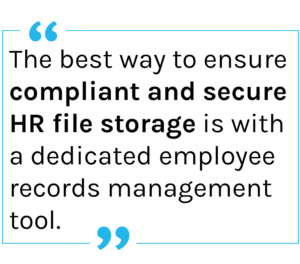Why is having employee records important?
Talent management is a central role for human resources teams across all types of organizations, including HigherEd. A core piece of successful talent management is employe records management, an often time-consuming but vital operation. Employee records management includes organizing and storing sensitive employee documents, like applications, payroll information, certifications, training records, and retirement documents, to name a few. Records maintenance helps HR teams ensure compliance and prepare for audits. But accurate employee records also inform things like tracking performance and productivity, creating talent profiles, examining salary equity, managing the employee lifecycle, and making strategic talent decisions.
HR records management was a historically manual process, involving hours spent filing documents. Even when institutions move to digital records, organizing those files without an employee records management system is time-consuming and complicated. That’s why leveraging an employee records software is the best path forward to a streamlined, secure, and audit-ready system of information.
HigherEd HR Challenges
HigherEd institutions need to keep track of and comply with a number of federal and state requirements and regulations, depending on whether they are public or private institutions. These range from EEO and FLSA to FMLA, HIPAA, and Title IX. Of course, other types of organizations need to work within these same regulations. However, HR in HigherEd is often made more complex because of decentralized structures, unique challenges like navigating work-study funding or research grants, and reconciling different processes or approaches across departments or schools. In addition, with so much to keep track of, HR teams should have the most up-to-date technology—but many institutions lack the tools to streamline their processes.
 To successfully navigate compliance reporting, HR teams need a lot of information. Accurate historical employee records are key. With a manual record management system, HR teams might be keeping employee data on paper records in individual files. This information can range from contact information and payroll activity to medical documentation, and often includes very sensitive information. There is a lot of manual effort involved in organizing and storing these files, and they’re not easily searchable for necessary information. Plus, if a file is lost, there’s not much that can be done.
To successfully navigate compliance reporting, HR teams need a lot of information. Accurate historical employee records are key. With a manual record management system, HR teams might be keeping employee data on paper records in individual files. This information can range from contact information and payroll activity to medical documentation, and often includes very sensitive information. There is a lot of manual effort involved in organizing and storing these files, and they’re not easily searchable for necessary information. Plus, if a file is lost, there’s not much that can be done.
The more secure and audit-ready way to manage employee records is digitally, but just moving files from paper to a computer isn’t enough. Without an employee records management system, you’re still digging for files and sorting and searching manually—just on a computer, instead of in a filing cabinet. The best way to ensure compliant and secure HR file storage is with a dedicated employee records management tool, like PeopleAdmin’s Employee Records.
Employee Records Software
PeopleAdmin’s Employee Records offers everything your HR team needs to organize, store, and manage all employee documents. The platform manages all types of forms, including I-9s, W-4s, benefits information, contracts, policy forms, bio updates, tuition benefits, FMLA documents, leave requests, custom forms built by your institution, and more. When everything is stored in one centralized portal, your team will have greater visibility, ensuring security for sensitive information and compliance across your institution, all while reducing time-consuming records management tasks. Plus, all faculty and staff can have self-service access to digital HR forms like change-of-address and FMLA documents, all without reaching out to HR to request them.
Employee Records also integrates seamlessly with the rest of the HigherEd Cloud, meaning that your team has oversight of the full employee lifecycle, as well as with other software that supports HR records management, like I-9 verification tools.
HR Records Management
Ready to make employee records management simpler at your institution? Reach out to our team to learn more.